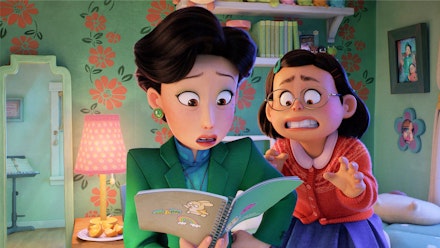In so many ways, Pixar’s Turning Red — the feature debut from Domee Shi, the filmmaker behind Oscar-winning short Bao — is all about asserting a renewed identity. Chinese-Canadian almost-teen Meilin (Rosalie Chiang), aka Mei, has an assured sense of self, right from the off; she’s an unapologetically dorky academic achiever who loves playing the flute, feeding her Tamagotchi, and pining over boyband 4*Town (sample song: ‘Girl, I Love Your Jeans’). But as puberty — and an additional spiritual transformation — rears its head, she changes; some of the old Mei is left behind, but the new Mei is a blast.

Shi’s film offers a new identity for Pixar, too. For once, this is not a buddy movie. It’s not an adventure flick either, resolutely a coming-of-age story from start to finish. The Ludwig Göransson score thrums and flutters like only a Ludwig score can. And the distinct visual style — incorporating anime speed-lines, face-filter emoji reactions, and a defiantly tween-girl pastel-pink sparkly sheen — means it looks unlike anything the studio has done before. Turning Red not only keeps Mei’s experiences and emotions at the heart of the story; the entire film feels like it’s filtered through her personality: ebullient and energetic and irresistible.

In typical Pixar style, Turning Red’s premise offers instinctual simplicity and wild invention. Pitched somewhere between Eighth Grade, The Incredible Hulk and Scott Pilgrim, it externalises Mei’s inner transformation into an allegory for bodily changes and evolving interpersonal relationships. Overnight, she goes from parents’ delight to literal raging hormone monster: when her magnified feelings of embarrassment, joy and anger manifest, she blows up into a giant red panda. For all the metaphors at play, Shi doesn’t shy away from the specific realities of teen girlhood either, with a frankness that would be refreshing in any movie, let alone a Pixar one — during Mei’s first transformation, she hides in the bathroom, her mother Ming (Sandra Oh) handing her sanitary pads as she assumes “the red peony” has bloomed.
The extraordinary finale offers an exquisite blend of spectacle and sentiment.
Turning Red isn’t just direct; it’s frequently unexpected, too. Most tellings of this story might involve Mei trying to keep the panda secret. Instead, Shi’s film is more about how Mei chooses to own this new side of herself, exploring the ways it impacts her relationship with her mum and her trio of ride-or-die besties, Miriam (Ava Morse), Priya (Maitreyi Ramakrishnan) and Abby (Hyein Park — a comedic standout).
Compared to the livewire opening half-hour, Turning Red’s middle act drags a little, pacing-wise, but the extraordinary finale offers an exquisite blend of spectacle and sentiment. While a climactic pop-concert kaiju battle (with pitch-perfect early-’00s pastiche songs penned by Billie Eilish and Finneas) offers real cinematic thrills, the moments that linger longest are the emotionally charged conversations and quieter personal revelations. Behind the burly exterior, the final reel is ultimately a dialogue between generations of Asian women — one which posits that the forces of familial love, self-acceptance and inherited destiny are as powerful as any boyband anthem. Long live the new Pixar.








